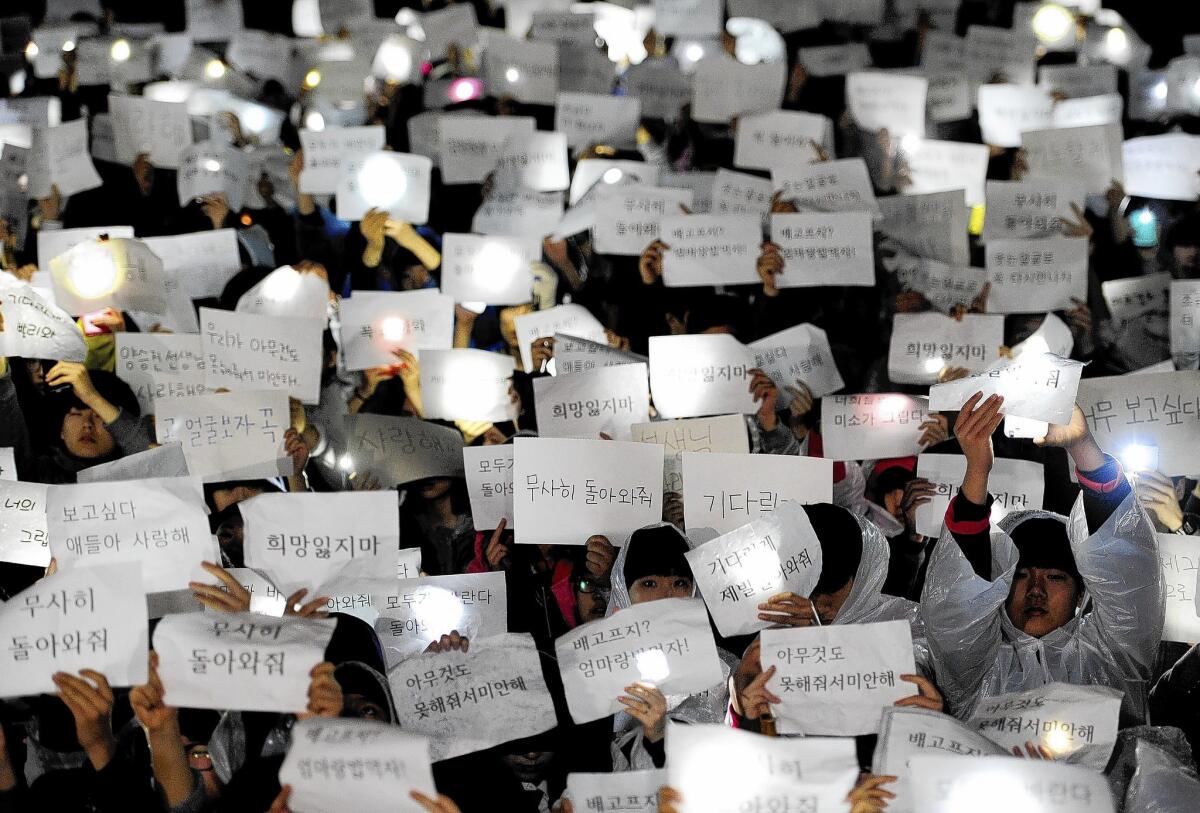South Korean ferry rescue efforts failing to find survivors

SEOUL — Divers struggled against strong currents and murky waters Friday morning in an effort to locate 271 people reported missing after a ferry sank off South Korea’s southwestern coast.
Water and weather conditions were making it difficult for divers to reach the Sewol, which sank Wednesday about 12 miles off the coast with 475 passengers aboard, many of whom were high school students on a field trip.
The death toll rose to 25, with some bodies floating to the water’s surface. Coast guard officials have said 179 people were rescued in the early hours of the disaster.
PHOTOS: South Korea ferry sinks
The missing passengers are presumed to be trapped in the ship, and the death toll is expected to rise.
Local news media reported Friday morning that rescue workers had heard no response after hammering on the Sewol’s hull. Coast guard officials also attempted to pump oxygen into the vessel, but those efforts were impeded by the strong currents.
Public criticism of the government’s rescue efforts have intensified, with many accusing authorities of being poorly prepared and slow to respond. An editorial in the Chosun Ilbo, the nation’s most widely circulated daily, called the sinking “yet another major tragedy that exposes the lack of attention paid here to safety.” An editorial in the JoongAng Daily excoriated the government for having “failed to grasp the seriousness of the accident.”
President Park Geun-hye toured the area by boat Thursday and later met with families of passengers. Tempers flared as parents argued for a larger-scale diving operation to find the missing.
Prime Minister Chung Hong-won was nearly attacked by grieving families as he arrived on the scene. Photos showed him being shielded from a water bottle thrown at him.
The Sewol was en route from Incheon on the northwestern coast to the southern resort island of Jeju when it went down about 9 a.m. Wednesday.
Officials said 500 divers, 169 boats and 29 planes had been mobilized to continue search operations.
On Thursday, the ship’s captain, Lee Joon-seok, made an emotional apology for fleeing the vessel before hundreds of others had a chance to get out. “I am really sorry,” he said in a broadcast by the YTN network. “I don’t know what to say. I’m sorry.”
The coast guard reported that Lee was filling in for the regular captain, who was on vacation.
The crew sent out distress calls when the vessel was east of the normal route, raising the possibility that the captain had taken a shortcut after fog delayed the vessel’s departure by three hours.
“It is possible that the ship changed its course to a different route because it was delayed leaving Incheon,” Lee Gyeong-og, vice minister of security and public administration, said at a news briefing. The company operating the ship, Cheonghaejin Marine Co., has denied that the course was changed.
Rim Gung-su, a professor at Mokpo National Maritime University with more than 30 years of experience as a ship captain, suspects that an abrupt turn and poorly secured cargo may have caused the ferry to list and eventually capsize.
“The ship was moving at full speed; it was very foggy and there were probably a lot of fishing boats around,” Rim said. “My theory is that the captain turned suddenly to the right to avoid a boat, which could have caused the cargo to fall over, throwing the Sewol off balance.”
Rim said cargo often is not properly secured to decks as operators seek to cut labor costs. The Sewol, about 480 feet long, can carry as many as 921 people, 180 vehicles and 152 shipping containers.
Built in 1994 in Japan, the ship was refurbished to increase its capacity shortly after it was purchased by Cheonghaejin Marine in 2012. Rim said he suspected the alterations could have raised the vessel’s center of gravity, making it more vulnerable to tipping in response to a shift of weight. Authorities have said the Sewol was fully licensed and operating legally.
Passengers reported hearing a loud noise before the sinking, followed by an immediate list that grew from about 15 degrees to 45 degrees within minutes.
Borowiec is a special correspondent.
More to Read
Sign up for Essential California
The most important California stories and recommendations in your inbox every morning.
You may occasionally receive promotional content from the Los Angeles Times.









